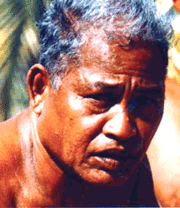“How shall we account for the Nation spreading itself so far over this Vast ocean?’ — Captain James Cook.
On the 17th of January, 1779, Cook piloted his ship Resolution into Kealakekua Bay on the island of Hawaii, writes Sam Low in Hawaiki Rising; Hokule’a, Nainoa Thompson, and the Hawaiian Renaissance (Island Heritage Publishing; 2013). On two previous voyages, Cook had explored deep into the Pacific, visiting the islands of New Zealand, Tahiti, Tonga and Samoa and everywhere he recognized the same lilting tones of the Polynesian language. He was a sailor-scholar who surmised these far flung islanders shared a similar culture.”
Captain Cook encountered large double canoes that sailed circles around his own ships. On his first voyage to Tahiti in 1769, he met Tupaia, a high priest and navigator who guided him through the Society Island chain. From memory, Tupaia described more than a hundred islands stretching from Tonga in the west to the Australs in the east — a distance of twelve hundred miles. Tupaia told Cook that navigators from Ra’iatea had sailed for twenty days or more aboard their large double canoes, called pahi, and in 1769 Cook had written in his log ‘In these Pahee…these people sail in those seas from Island to island for several hundred Leagues (about 600 nautical miles), the sun serving them for a compass by day and the Moon and stars by night. When this comes to be prov’d we shall be no longer at a loss to know how these Islands sying in those seas came to be people’d.” (Low, 19-21.)
Hokule’a, the tradional Polynesian voyaging canoe, has over the past thirty years or so, made numerous voyages all over the Pacific Ocean, without instruments and on wind power alone, proving that Polynesians could have settled the Pacific intentionally, and that their vessels were capable and their navigational methods accurate. Indeed, that is the accepted theory now. Polynesians, orginally from southern Asia, peopled the Pacific Islands over many hundreds of years. Theirs is not the story of two guys out fishing on a raft who get blown off course and end up in Hawaii, but of purposeful voyagemaking and emigration with navigators, food and fresh water, and women aboard. Thor Heyerdahl’s thory of American origins “seems no longer tenable in face of the accumulated evidence from archaeology, word analysis, studies of introduced plnats and animals, and other data, says David Lewis in We the Navigators; the Ancient Art of Landfinding in the Pacific (University of Hawaii Press; 1972).
Today’s traditional navigators were taught by Mau Piailug, a Micronesian navigator from Satawal, who passed along a dying art before he himself passed on in 2010. Some of today’s Hawaiian traditional navigators who studied with Mau include Nainoa Thompson, Chad Baybayan, Shorty Bertelmann, Bruce Blankenfeld and Chad Paishon. The practice has been revived and proves that humans can intentionally cross an ocean without use of compass, quadrants, charts or other western technology.
Captain Cook, an astute observer and admirer of Polynesian seamanship, would smile knowingly.
Sources:
Hawaiki Rising; Hokule’a, Nainoa Thompson, and the Hawaiian Renaissance Sam Low ( Island Heritage; 2013).
The Explorations of Captain James Cook in the Pacific as told by selections of his own journals 1768-1779. Ed. Grenfell Price (Dover; 1971)
Tupaia; Captain Cook’s Polynesian Navigator. Joan Druett (Praeger, 2010).
Voyage of Rediscovery; a cultural odyssey through Polynesia. Ben Finney (University of California Press; 1994.)
We, the Navigators; The Ancient Art of Landfinding in the Pacific.( second edition). David Lewis (University of Hawaii Press; 1994)
